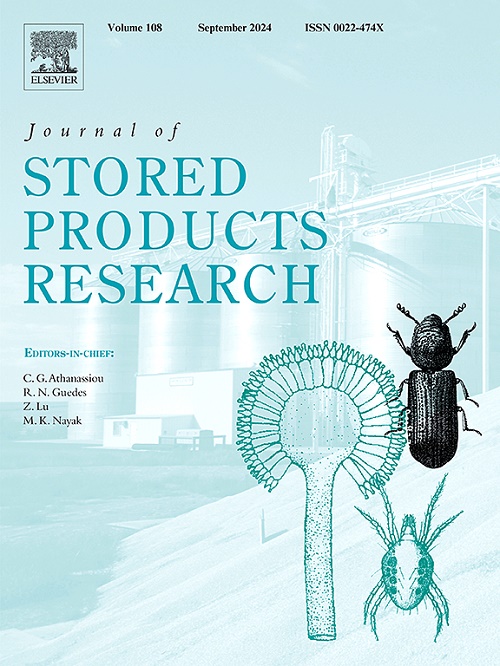Synergetic enhancement of insecticidal efficacy of graphene with spinosad against major stored grain insects
IF 2.7
2区 农林科学
Q1 ENTOMOLOGY
引用次数: 0
Abstract
Pest resistance caused by repeated and excessive use of conventional pesticides has emerged as a significant challenge in modern agriculture, threatening global food security and the sustainability of agricultural practices. To address this challenging problem and shift away from dependence on chemical pesticides to more sustainable nanotechnology-based approaches, this paper presents a study exploring the combined use of graphene and biopesticide for advanced pest control. Naturally derived spinosad as a natural neurotoxin with lower resistance risks was combined with graphene-based nanopesticides offering efficient, and environmentally friendly pest control are explored to manage three key pests of stored products: Tribolium castaneum (Herbst), Oryzaephilus surinamensis (L.) and Rhyzopertha dominica (F.). The study assessed the insecticidal effectiveness of graphene (250 ppm), spinosad (200 and 400 ppm), and their combinations (250 ppm graphene + 200 ppm spinosad, and 250 ppm graphene + 400 ppm spinosad). Mortality rates were measured at 7-, 14-, and 21-days post-exposure, while progeny production was evaluated 65 days after treatment. Results indicated that the combination of graphene and spinosad significantly increased insect mortality across all three species when compared to either substance alone. Rhyzopertha dominica was the most susceptible in all spinosad treatments, both alone and in combination with graphene. Oryzaephilus surinamensis showed 97% mortality in graphene/200 spinosad, while T. castaneum, known for its tolerance to spinosad, showed lower mortality rates. Regarding progeny production, O. surinamensis exhibited zero progeny in all graphene-spinosad treatments, while R. dominica recorded complete inhibition of progeny in all treated groups. In contrast, T. castaneum showed fewer offspring compared to untreated controls. The increased efficacy of the graphene-spinosad combination appears to be due to graphene's ability to enhance contact with the insect cuticle, facilitating better penetration of spinosad and prolonging its insecticidal effects.
石墨烯与棘糖协同增强对主要储粮害虫的杀虫效果
重复和过度使用常规农药造成的有害生物抗药性已成为现代农业面临的重大挑战,威胁到全球粮食安全和农业做法的可持续性。为了解决这一具有挑战性的问题,并从依赖化学农药转向更可持续的基于纳米技术的方法,本文提出了一项研究,探索石墨烯和生物农药的联合使用,以实现先进的害虫防治。将天然衍生的棘糖作为一种抗性风险较低的天然神经毒素,与石墨烯基纳米农药结合使用,探索了高效、环保的害虫防治方法,以控制储藏产品中的三种主要害虫:castaneum (Herbst)、Oryzaephilus surinamensis (L.)和Rhyzopertha dominica (F.)。该研究评估了石墨烯(250 ppm)、spinosad(200和400 ppm)及其组合(250 ppm石墨烯+ 200 ppm spinosad, 250 ppm石墨烯+ 400 ppm spinosad)的杀虫效果。在接触后7、14和21天测量死亡率,在治疗后65天评估后代产量。结果表明,与单独使用任何一种物质相比,石墨烯和spinosad的组合显著增加了所有三种昆虫的死亡率。在所有spinosad处理中,无论是单独处理还是与石墨烯联合处理,Rhyzopertha dominica都是最敏感的。在石墨烯/200 spinosad中,Oryzaephilus sulinamensis的死亡率为97%,而对spinosad具有耐受性的castaneum的死亡率较低。在后代产生方面,所有石墨烯-spinosad处理下,O. surinamensis的后代均为零,而R. dominica的后代在所有处理组中均被完全抑制。相比之下,与未经处理的对照组相比,castaneum显示出较少的后代。石墨烯-spinosad复合材料的功效增加似乎是由于石墨烯能够增强与昆虫角质层的接触,从而促进spinosad更好地渗透并延长其杀虫效果。
本文章由计算机程序翻译,如有差异,请以英文原文为准。
求助全文
约1分钟内获得全文
求助全文
来源期刊
CiteScore
5.70
自引率
18.50%
发文量
112
审稿时长
45 days
期刊介绍:
The Journal of Stored Products Research provides an international medium for the publication of both reviews and original results from laboratory and field studies on the preservation and safety of stored products, notably food stocks, covering storage-related problems from the producer through the supply chain to the consumer. Stored products are characterised by having relatively low moisture content and include raw and semi-processed foods, animal feedstuffs, and a range of other durable items, including materials such as clothing or museum artefacts.

 求助内容:
求助内容: 应助结果提醒方式:
应助结果提醒方式:


